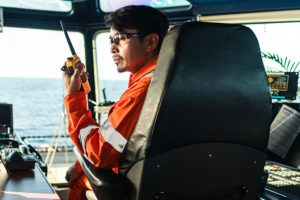Digital solutions enhance seafarer safety

From time immemorial, seafarers and ships have provided vital links to keep the world connected.
Even today, as digital transformation brings far-flung communities together amid the COVID-19 pandemic, maritime trade and transport remain central elements in global connectivity.
Seafarers and their demanding missions, meanwhile, are changing with the times.
Connecting mariners to the rest of the world and providing them with the best technologies and services to keep them safe at sea is of utmost importance.
Connected seafarers
More and more connected ships mean increasingly huge amounts of data. Most importantly, we must ensure that nobody is left behind. In the maritime sector, this means helping seafarers understand the latest information and communication technologies (ICTs) well enough to extract real value from the resulting data.
Gathering and analyzing data in intelligent ways makes all of us in the maritime business more effective in our missions. I have seen firsthand how ICT adoption can help to build a safer and fairer work environment for seafarers, address global environmental concerns including warming oceans, biodiversity loss and rising sea levels, and, of course, optimize maritime fleet performance.
To take one example, key shipboard data can be transmitted securely thanks to emerging technologies like distributed ledgers.
At the same time, access to satellite data while at sea has never been easier. Seafarers can capture deep insights through a new-generation interface with their equipment. Ultimately, satellite-based meteorology has vastly improved our knowledge of the seas.
For those in peril
Safety has always been priority number one for seafarers. Yet the perils of the harsh maritime working environment are never far away. ICT uptake and standardization have greatly improved seafarer safety in recent years, with the International Telecommunication Union (ITU) making vital contributions in this regard.
Take, for example, the Global Maritime Distress and Safety System (GMDSS), the internationally agreed set of safety procedures, frequencies, types of equipment, and communication protocols developed by ITU and the International Maritime Organization (IMO). GMDSS has been saving lives for over 30 years now. It came as an especially welcome innovation back in 1988.
Today, ITU’s Maritime Manual, List IV (List of Coast Stations and Special Service Stations) and List V (List of Ship Stations and Maritime Mobile Service Identity Assignments) remain highly reliable sources of industry information. They equip our seafaring colleagues to anticipate navigational concerns and ultimately help bring ships and crews home safe and sound.
After many years of travelling the oceans, I appreciate the value of practical tech of seaborne users. My wish to leverage digital solutions and design user-first services is what led me to the next stage of my career. Now, at Opsealog, my mission is to provide crews and shore staff with dedicated tools and accurate advice for the best use of resources.
Evolving technologies, meanwhile, keep unlocking new possibilities. I can’t wait to help create the next generation digital tools for our beautiful maritime industry.
[source: ITU]

